What is Diatom?
- Diatoms are small organisms found in oceans, waterways, and soil all around the world. They belong to a group of algae called microalgae. These tiny creatures play a big role in our environment. They produce a lot of oxygen, about 20 to 50 percent of the Earth’s total, which is really important for us to breathe. They also take in a lot of silicon from the water they live in, and they make up almost half of the organic material in the oceans.
- Diatoms are single-celled organisms, and they can live alone or in groups. They come in various shapes and sizes, ranging from 2 to 200 micrometers. They reproduce by splitting into new cells, and they can double in number about every day if they have enough nutrients and sunlight.
- One interesting thing about diatoms is that they have a hard outer shell made of silica, which is a type of material found in glass. These shells can be really colorful and are sometimes called “jewels of the sea.” Diatoms can move around passively in water currents and turbulence, and some types even have flagella to help them swim.
- Diatoms are like tiny factories that use sunlight to make energy through a process called photosynthesis, just like plants. They are a type of plankton, which are tiny organisms that float in the water. Diatoms are an important part of the ocean’s food chain, providing energy for many other creatures, from small fish to big whales.
- Scientists study diatoms to understand more about the environment, and they can tell a lot about water quality from studying diatoms. These little organisms are also used in various ways, like in water filters and even as dynamite stabilizers. Despite their small size, diatoms have a big impact on our world and are truly fascinating to explore under a microscope.
Definition of Diatom
A diatom is a tiny, single-celled algae with a hard shell made of silica, found in oceans, waterways, and soil. They play a crucial role in oxygen production, nutrient cycling, and the food web of aquatic ecosystems.
Scientific classification of Diatom
| Domain: | Eukaryota |
| Clade: | Diaphoretickes |
| Clade: | SAR |
| Clade: | Stramenopiles |
| Phylum: | Gyrista |
| Subphylum: | Ochrophytina |
| Infraphylum: | Diatomista |
| Superclass: | Khakista |
| Class: | Bacillariophyceae Dangeard, 1933 |
Distribution of Diatom
- Diatoms are found in a wide range of places, making them a highly distributed group of organisms. You can discover diatoms in oceans, freshwater bodies, soil, and on surfaces that are damp. They play a significant role in many ecosystems.
- In the oceans, diatoms are quite abundant. They are a major part of phytoplankton, which are tiny plants that float on the surface of the water. They thrive in nutrient-rich coastal waters and are especially prominent during oceanic spring blooms. These blooms happen when diatoms multiply quickly, outpacing other types of phytoplankton. Some diatoms prefer to live right at the water’s surface, forming films, while others may settle near the interface between water and sediment, or even in moist atmospheric conditions.
- When it comes to their role in oceans, diatoms are vital. They contribute about 45% of the total organic material produced through primary production in the oceans. In simple terms, they play a big part in creating the building blocks of life in the ocean.
- However, diatoms have certain limits to where they are found. Their distribution is not uniform across all areas of the oceans. They have specific horizontal (side-to-side) and vertical (up-and-down) zones where they tend to be more concentrated. These zones influence where diatoms are found and how they interact with their environment.
- In essence, diatoms have managed to establish themselves in various aquatic and terrestrial habitats, contributing significantly to the ecosystems they inhabit. Their distribution in the oceans is particularly important due to their role in primary production, which is a fundamental process that supports life throughout the marine food chain.
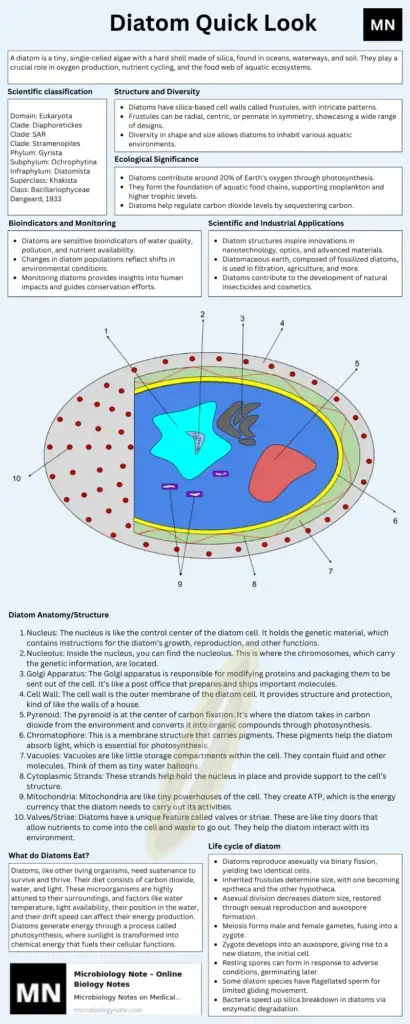
Morphology of Diatom
- The morphology, or physical characteristics, of diatoms is quite fascinating and unique. Diatoms are very small, usually ranging from 2 to 200 micrometers in size, although some can be larger. They have a distinct color due to their yellowish-brown chloroplasts, which are important for photosynthesis. These chloroplasts have an interesting structure with four cell membranes and contain pigments like fucoxanthin.
- Diatoms typically don’t have flagella, which are whip-like structures that help with movement, except for the male gametes of some types. These gametes have a specific structure that includes mastigonemes, which are tiny hairs found in other groups of organisms.
- One of the most striking features of diatoms is their beautiful appearance, often referred to as the “jewels of the sea” or “living opals.” They have a unique coloration that comes from their intricate and porous cell walls made primarily of silica. These walls can have various patterns, pores, spines, and ridges, which are used to classify different types of diatoms.
- The diatom cell is made up of two halves, each containing a flat plate called a valve, and a connecting band called a girdle. These halves have specific names: the smaller half is the hypotheca, and the larger half is the epitheca. Diatoms come in different shapes, like circles, triangles, squares, and ellipses, but they all have a hard shell made of opal (silicic acid).
- Diatoms can be divided into two groups based on the shape of their shells. The first group is called centric diatoms, which have radial symmetry. They have upper and lower valves that can slide underneath each other, allowing the cell to expand. The second group is called pennate diatoms, which have bilateral symmetry. Their valves have slits along the raphes, and they move by streaming cytoplasm along these slits.
- In centric diatoms, the cytoplasm lines the inner surface of the shell and surrounds a large central vacuole filled with a fluid called “cell sap.” This central vacuole plays an important role in the cell’s structure and function. Centric diatoms have different shapes and sizes, determined by the direction their shell extends and whether they have spines.
- Overall, the morphology of diatoms is a complex and fascinating subject, with their intricate cell walls and unique shapes contributing to their remarkable beauty and importance in the natural world.
Diatom Anatomy/Structure
Diatom anatomy refers to the various structures and organelles that make up these single-celled organisms. Here are some key components of diatom anatomy:
- Nucleus: The nucleus is like the control center of the diatom cell. It holds the genetic material, which contains instructions for the diatom’s growth, reproduction, and other functions.
- Nucleolus: Inside the nucleus, you can find the nucleolus. This is where the chromosomes, which carry the genetic information, are located.
- Golgi Apparatus: The Golgi apparatus is responsible for modifying proteins and packaging them to be sent out of the cell. It’s like a post office that prepares and ships important molecules.
- Cell Wall: The cell wall is the outer membrane of the diatom cell. It provides structure and protection, kind of like the walls of a house.
- Pyrenoid: The pyrenoid is at the center of carbon fixation. It’s where the diatom takes in carbon dioxide from the environment and converts it into organic compounds through photosynthesis.
- Chromatophore: This is a membrane structure that carries pigments. These pigments help the diatom absorb light, which is essential for photosynthesis.
- Vacuoles: Vacuoles are like little storage compartments within the cell. They contain fluid and other molecules. Think of them as tiny water balloons.
- Cytoplasmic Strands: These strands help hold the nucleus in place and provide support to the cell’s structure.
- Mitochondria: Mitochondria are like tiny powerhouses of the cell. They create ATP, which is the energy currency that the diatom needs to carry out its activities.
- Valves/Striae: Diatoms have a unique feature called valves or striae. These are like tiny doors that allow nutrients to come into the cell and waste to go out. They help the diatom interact with its environment.
Understanding diatom anatomy gives us insight into how these microscopic organisms function and survive. Each of these components plays a specific role in the diatom’s life, allowing it to carry out essential processes like growth, reproduction, and energy production.
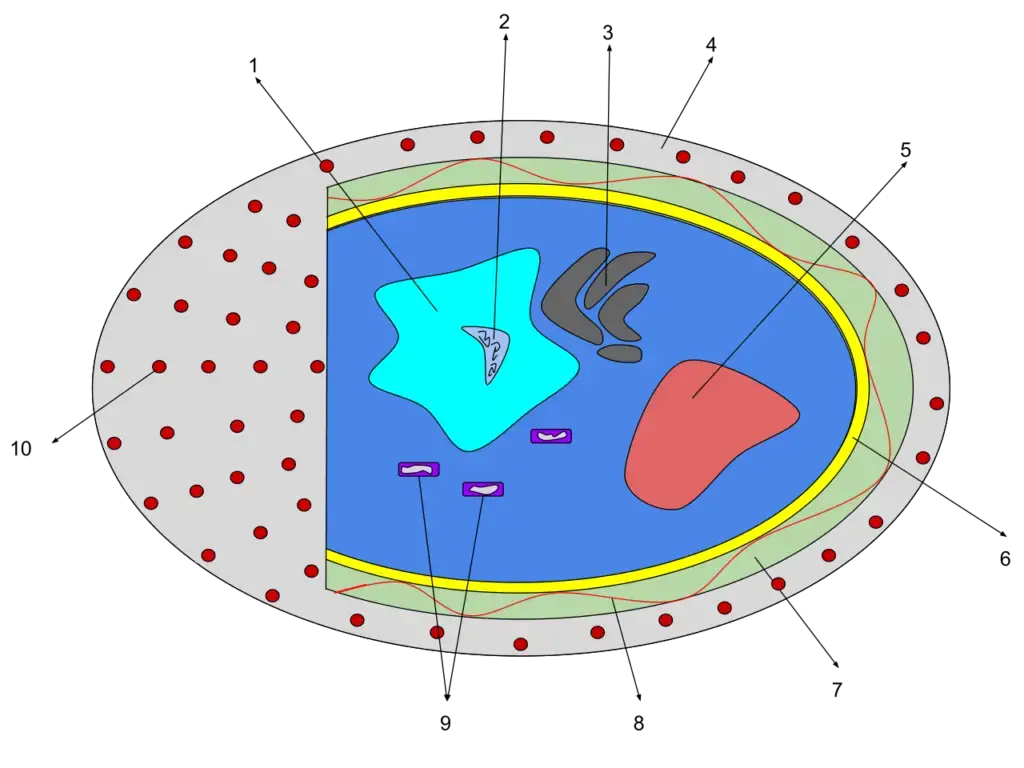
Intricate structures of the diatom
Diatoms have fascinating and intricate structures that make them unique and special. These structures are like tiny features that help us identify and understand different types of diatoms.
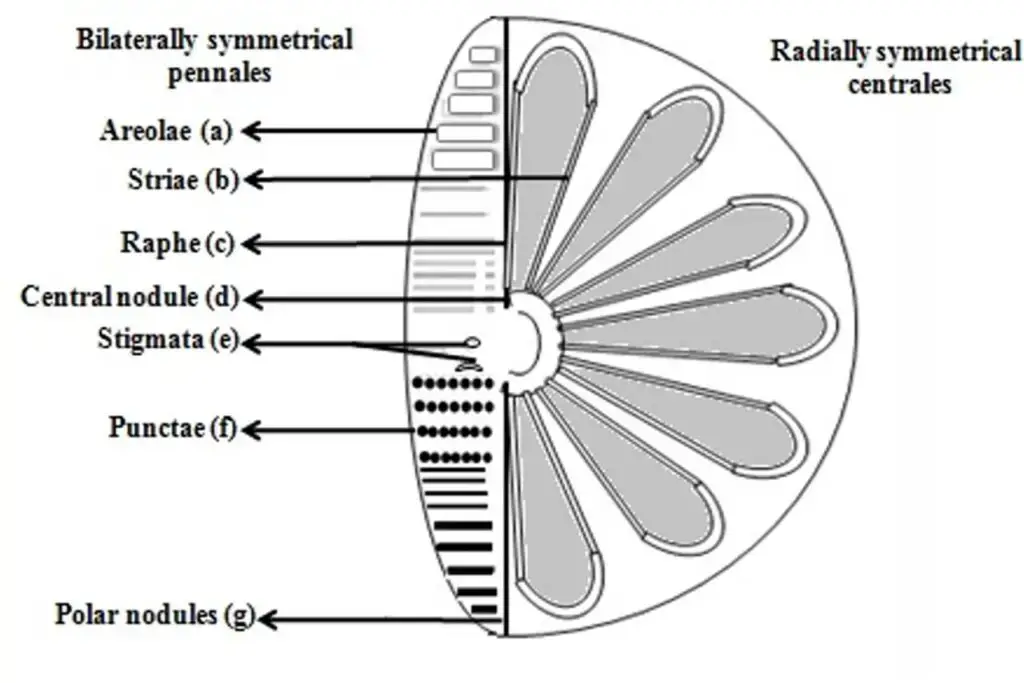
- One of these features is called areolae, which are like tiny hexagonal or polygonal boxes on the surface of a diatom. These boxes have a sieve-like pattern, and they play a role in the diatom’s overall structure.
- Another important feature is called striae. These are like lines of small pores, spots, or dots on the surface of the diatom. Imagine them as tiny dots forming a line, like beads on a string.
- The diatom also has something called a raphe, which is like a small slit in its valves, the outer parts of its shell. This raphe helps with movement and other functions of the diatom.
- Right in the middle of the raphe, there’s a central nodule, which is like a thickening of the diatom’s wall. This nodule adds strength and stability to the diatom’s structure.
- The diatom also has stigmata, which are holes on the surface of its valves. These holes might look round from the outside, but inside, they have a slit-like shape. It’s an interesting feature that serves a specific purpose.
- Punctae are spots or tiny holes on the diatom’s surface. They’re like little dimples that add texture to the diatom’s overall appearance.
- At the ends of the raphe, there are polar nodules, which are thickened parts of the diatom’s wall. These nodules provide extra support to the diatom and are located at the far ends of the slit-like raphe.
All these intricate structures—like the areolae, striae, raphe, central nodule, stigmata, punctae, and polar nodules—come together to create the unique and beautiful appearance of diatoms. Studying these features helps scientists classify and understand different types of diatoms and their important roles in our environment.
Silicification in diatom
- The process of silicification in diatoms is a remarkable and intricate one. Diatom cells are enclosed within a special shell made of silica, called a frustule. This frustule has two parts known as thecae, which usually overlap each other. The silica that makes up the frustule is produced inside the cell by linking together silicic acid molecules. This material is then pushed outside the cell and added to the frustule.
- When a diatom divides to create two new cells, each cell keeps one of the two halves of the frustule and grows a smaller half within it. This can lead to a decrease in the average size of diatom cells over time. But when diatoms become very small, instead of continuing to divide, they produce a special structure called an auxospore. This auxospore grows into a much larger cell, which then divides and starts the process again. This auxospore formation is often connected to sexual reproduction in diatoms.
- Scientists are still studying how diatoms move the silica they absorb to the frustule. They’ve found certain proteins, like silaffins, in some diatoms that play a role in this process. These proteins help create complex and patterned structures in the frustule, adding to the unique appearance of diatoms. These proteins are specific to diatoms and are not found in other species.
- Researchers have been working to understand the exact mechanism by which diatoms create these structures. They’ve discovered that certain regions of the frustule, called Silica Deposition Vesicles (SDVs), are important for silica deposition. These SDVs are acidic compartments that fuse with other vesicles derived from the Golgi apparatus. The proteins inside these compartments, like silaffins, work together to build sheets of silica with intricate patterns.
- The ability of diatoms to create these silica-based structures has fascinated scientists for a long time. Early observers in the 1700s noted the regular patterns of diatom frustules and recognized them as living, mineral-utilizing organisms. It wasn’t until later that the main chemical component of the frustule was identified as silicic acid.
- Over time, researchers have made significant progress in understanding the biochemical processes involved in diatom silicification. They’ve identified various components, proteins, and vesicles that play a role in this process. This research not only sheds light on how diatoms create their unique frustules but also provides insights into how these structures are assembled and how they contribute to the diatom’s growth and reproduction.
Behaviour of diatom
- Diatoms display interesting behaviors in their aquatic environments, influenced by their unique physical features.
- Many diatoms, particularly the centric and araphid pennate types, do not possess the ability to move on their own. Their dense cell walls make them prone to sinking in water. When found in open water, these diatoms rely on the wind-induced turbulence of the ocean’s upper layers to keep them suspended closer to the sunlit surface. To enhance their chances of staying afloat, some planktonic diatoms have developed strategies to slow down their sinking, like growing spines or forming chains of cells. These adaptations increase their surface area relative to their volume and create more drag, allowing them to remain suspended in the water for longer periods. Some individual diatom cells can even adjust their buoyancy by using an ionic pump mechanism.
- Certain pennate diatoms possess a unique way of movement known as “gliding.” They can move across surfaces by secreting sticky mucilage through a structure called the raphe. To glide effectively, a diatom cell needs a solid surface for the mucilage to stick to.
- Diatom cells can be found either on their own or organized into colonies of different types. These colonies can be connected by siliceous structures, mucilage pads, stalks, tubes, or threads of chitin, a type of polysaccharide. These processes extend from the cell’s surface and help diatoms interact and form aggregates.
- In summary, diatoms exhibit behaviors such as relying on currents and turbulence to stay afloat, employing mechanisms to slow sinking, and some even have the ability to glide across surfaces. Additionally, diatoms can form colonies and use various structures to connect and interact with one another. These behaviors highlight the adaptability and uniqueness of these microscopic organisms in their aquatic habitats.
What do Diatoms Eat?
- Diatoms, like other living organisms, need sustenance to survive and thrive. Their diet consists of carbon dioxide, water, and light. These microorganisms are highly attuned to their surroundings, and factors like water temperature, light availability, their position in the water, and their drift speed can affect their energy production. Diatoms generate energy through a process called photosynthesis, where sunlight is transformed into chemical energy that fuels their cellular functions.
- In the course of photosynthesis, diatoms also release molecular oxygen into the environment. Remarkably, diatoms contribute around 25% of the Earth’s total oxygen production. While diatoms share similarities with plants due to their ability to undergo photosynthesis, it’s important to note that plants and diatoms acquired this capability through separate evolutionary paths.
- What truly sets diatoms apart from other microorganisms is their distinctive cell wall, known as a frustule, which is composed of inorganic silica. This glassy frustule bestows diatoms with their unique shape and appearance. Interestingly, constructing this frustule demands less energy compared to building conventional cell membranes. Nonetheless, a significant portion of a diatom’s energy resources is allocated to producing silica polymers inside the cell, which are used to construct the frustule. Moreover, diatoms utilize dissolved silica present in seawater to manufacture this intricate frustule structure.
Life cycle of diatom
The life cycle of diatoms involves a series of stages that contribute to their reproduction and growth.
- Reproduction and Cell Size: Diatoms reproduce asexually through a process called binary fission. During this process, a diatom divides into two parts, resulting in two new diatoms with identical genes. Each new diatom receives one of the parent’s two frustules (the silica cell walls). One frustule is larger, becoming the epitheca, while the other is smaller and used to construct a new, smaller frustule called the hypotheca. The diatom that inherits the larger frustule remains the same size as the parent, while the one with the smaller frustule becomes smaller. This causes the average size of the diatom population to decrease. Some diatom taxa can divide without reducing their size, but to restore size, sexual reproduction and auxospore formation are needed.
- Cell Division: Diatom cells are diploid, meaning they have two sets of chromosomes. Meiosis, a process that forms gametes (male and female reproductive cells), takes place in these cells. Male and female gametes fuse to create a zygote. The zygote develops into a large sphere called an auxospore, shedding its silica frustule. Inside the auxospore, a new diatom cell, called the initial cell, forms. This marks the beginning of a new generation. Resting spores can also be formed in response to unfavorable conditions, with germination occurring when conditions improve.
- Sperm Motility: Most diatoms are not capable of movement, but some species have flagellated sperm, which can move in a gliding motion. In centric diatoms, small male gametes have one flagellum, while the larger female gametes are non-motile. In pennate diatoms, both male and female gametes lack flagella. Certain pennate diatoms without a seam-like structure called a raphe are considered transitional between centric and raphid pennate diatoms.
- Degradation by Microbes: Certain bacteria in oceans and lakes can speed up the breakdown of silica in both living and dead diatoms. They use enzymes to break down the organic material of the diatoms, leading to the dissolution of their silica cell walls.
In summary, the life cycle of diatoms involves asexual reproduction through binary fission, sexual reproduction through meiosis and gamete fusion, and the formation of auxospores and resting spores. The size of diatoms can decrease due to asexual division, but sexual reproduction and auxospore formation help restore their size. Some diatoms have mobile sperm, and the breakdown of their silica frustules can be accelerated by certain bacteria.
Biogeochemistry of Diatom
The biogeochemistry of diatoms involves their role in cycling essential elements within aquatic ecosystems. Here are some key aspects of the biogeochemistry of diatoms:
- Silica Cycle: Diatoms play a significant role in the silica cycle, which involves the cycling of silicon in aquatic environments. They extract dissolved silicic acid from surface waters as they grow, incorporating it into their cell walls made of silica. When diatoms die, their silica-rich frustules sink to the ocean floor, contributing to the formation of sediment. Inputs of silicon also come from aeolian dust, rivers, and seafloor processes. The rise of diatoms in the silicon cycle has been a relatively recent phenomenon, and their dominance has impacted the cycling of silicon in marine environments.
- Carbon Cycle: Diatoms are vital contributors to the ocean carbon cycle. Through photosynthesis, they fix carbon dioxide from the atmosphere, converting it into organic matter. This process, known as the biological carbon pump, plays a crucial role in transferring carbon from the surface ocean to deeper layers, sequestering atmospheric carbon dioxide for extended periods. Diatoms have carbon dioxide concentrating mechanisms that enable them to sustain marine food chains and contribute to the removal of carbon from the carbon cycle.
- Urea Cycle: Diatoms possess a functional urea cycle, a feature they share with animals. The urea cycle is involved in nitrogen metabolism and helps regulate nutrient exchange between different cellular compartments. This cycle distinguishes diatoms from other photosynthetic organisms and contributes to their adaptation to changing nutrient conditions.
- Alternative Respiration: In environments lacking oxygen and sunlight, diatoms can switch to anaerobic respiration, known as nitrate respiration. This adaptation allows them to remain dormant for extended periods, contributing to their survival in challenging conditions.
- Pigments: Diatoms contain various pigments, including chlorophylls, beta-carotene, and fucoxanthin, which play essential roles in photosynthesis and light absorption.
Overall, the biogeochemistry of diatoms involves their crucial contributions to elemental cycles, carbon sequestration, and nutrient dynamics in aquatic ecosystems. Their unique metabolic pathways and adaptations make them key players in shaping the chemical composition and ecological functioning of marine environments.
Importance of Diatom
Diatoms hold significant importance in various fields due to their unique characteristics and functions.
- Paleontology: The decomposition of diatoms contributes to the formation of organic and inorganic sediment, including silicates. This sediment provides valuable insights into past marine environments when analyzed through corings of ocean floors or bay muds. The inorganic matter preserved in these sediments forms a geological record of marine strata, aiding in the study of historical marine conditions.
- Industrial Uses: Diatoms and their shells, known as frustules, have practical industrial applications. Diatomite or diatomaceous earth, made from diatom frustules, is used for fine polishing and liquid filtration. The intricate structure of their microscopic shells has even been explored for potential applications in nanotechnology. Diatomite, considered a natural nanomaterial, finds diverse uses such as ceramics production, filtration material, catalyst support, and more.
- Nanotechnology Possibilities: The deposition of silica by diatoms has caught the attention of nanotechnology researchers. Diatom cells construct various shapes and sizes of valves, suggesting the potential to manufacture micro- or nano-scale structures. These structures could find applications in optical systems, semiconductor nanolithography, and drug delivery systems. Diatoms might be cultivated to mass-produce nanoscale components with specific shapes and sizes. Additionally, diatoms have been proposed as a component in solar cells, offering potential advancements in renewable energy technology.
- Forensic Analysis: Diatoms play a role in forensic investigations, especially in distinguishing between deaths by submersion and post-mortem immersions. Laboratory tests can detect diatoms in decomposed bodies due to their resistance to decay. If diatoms of the same species are found in the body and the surrounding water, it can indicate drowning as the cause of death. The composition of diatom species in the body can also provide insights into the site of drowning.
Ecological Importance of Diatom
Diatoms play a crucial role in various ecological processes and contribute significantly to the health and balance of aquatic ecosystems. Their ecological importance can be understood in several ways:
- Primary Producers: Diatoms are primary producers in aquatic ecosystems, meaning they are the base of the food chain. Through photosynthesis, they convert sunlight, carbon dioxide, and nutrients into organic matter, providing essential energy and nutrients for other organisms in the ecosystem.
- Oxygen Production: Diatoms are responsible for a significant portion of the Earth’s oxygen production. During photosynthesis, they release oxygen as a byproduct, contributing to the oxygen content of aquatic environments and the atmosphere.
- Carbon Fixation: Diatoms play a critical role in the global carbon cycle. They absorb carbon dioxide from the atmosphere and incorporate it into their organic tissues through photosynthesis. When diatoms die and sink to the ocean floor, they transport carbon to deeper layers, contributing to carbon sequestration and influencing climate regulation.
- Food Source: Diatoms are a primary food source for various aquatic organisms, including zooplankton, small fish, and filter-feeding invertebrates. These organisms, in turn, serve as prey for larger predators, forming complex food webs that support the entire aquatic ecosystem.
- Nutrient Cycling: Diatoms are efficient at cycling nutrients like nitrogen, phosphorus, and silica in aquatic systems. They take up these nutrients from the water, incorporating them into their cells. When diatoms are consumed or die, their nutrients are released back into the ecosystem, supporting the growth of other organisms.
- Habitat Formation: Diatoms can form intricate and diverse habitats in aquatic environments. Their cell walls contribute to the structure of biofilms, which provide shelter and substrate for other microorganisms and small aquatic animals.
- Water Clarity and Quality: Diatoms can influence water clarity by affecting light penetration. They contribute to the absorption and scattering of light, which can influence the underwater environment. Moreover, diatoms play a role in nutrient uptake and water purification, helping to maintain water quality.
- Indicator Species: The presence and abundance of specific diatom species can serve as indicators of environmental conditions, such as water quality and nutrient levels. Diatom communities can provide valuable information about the health and ecological status of aquatic ecosystems, aiding in environmental monitoring and management.
In summary, diatoms are ecologically important organisms that drive key processes in aquatic ecosystems, including primary production, nutrient cycling, carbon sequestration, and food webs. Their interactions with other organisms and their responses to environmental changes make them essential components of healthy and balanced aquatic environments.
Diatoms Under Microscope
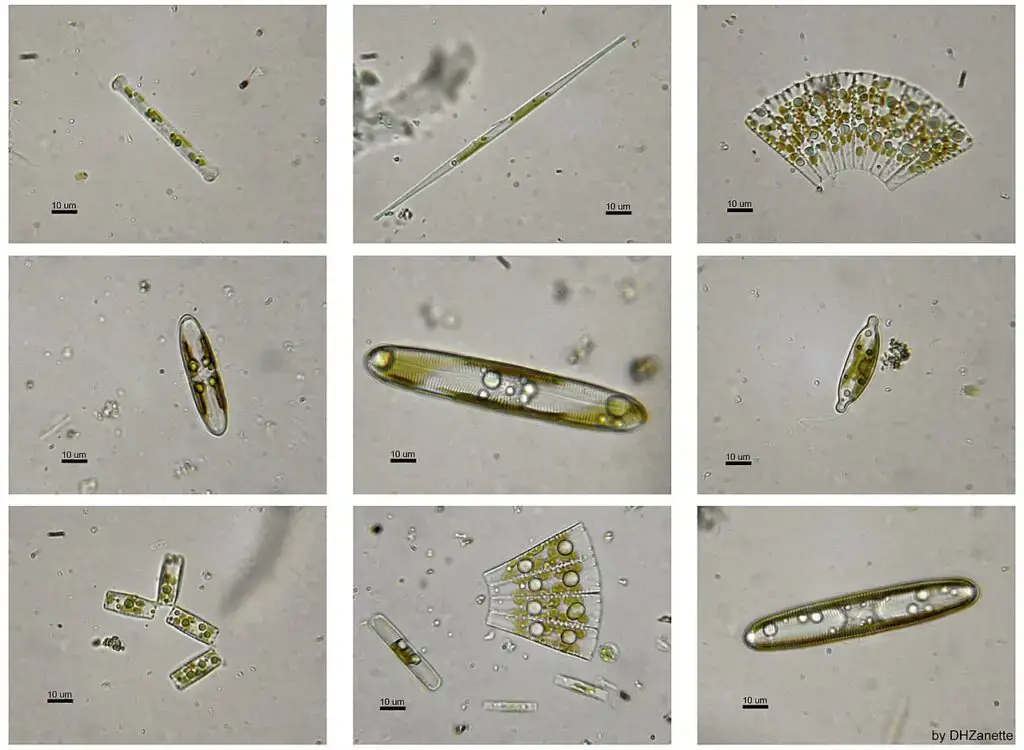
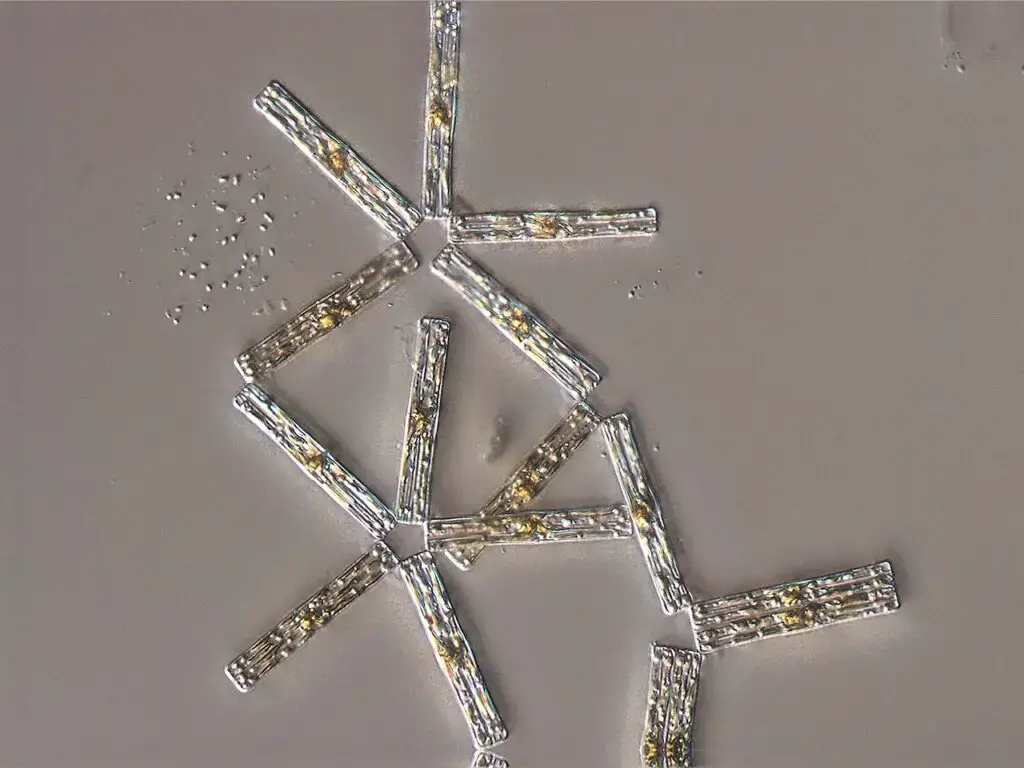
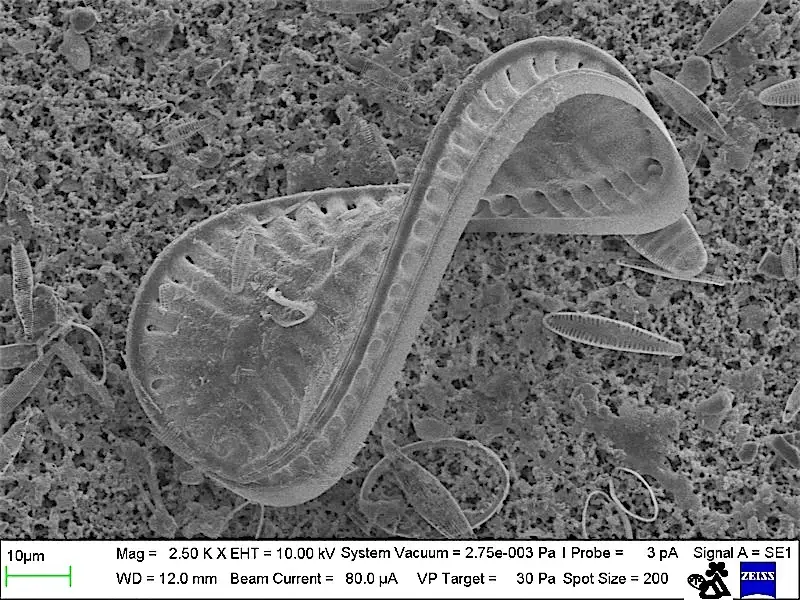
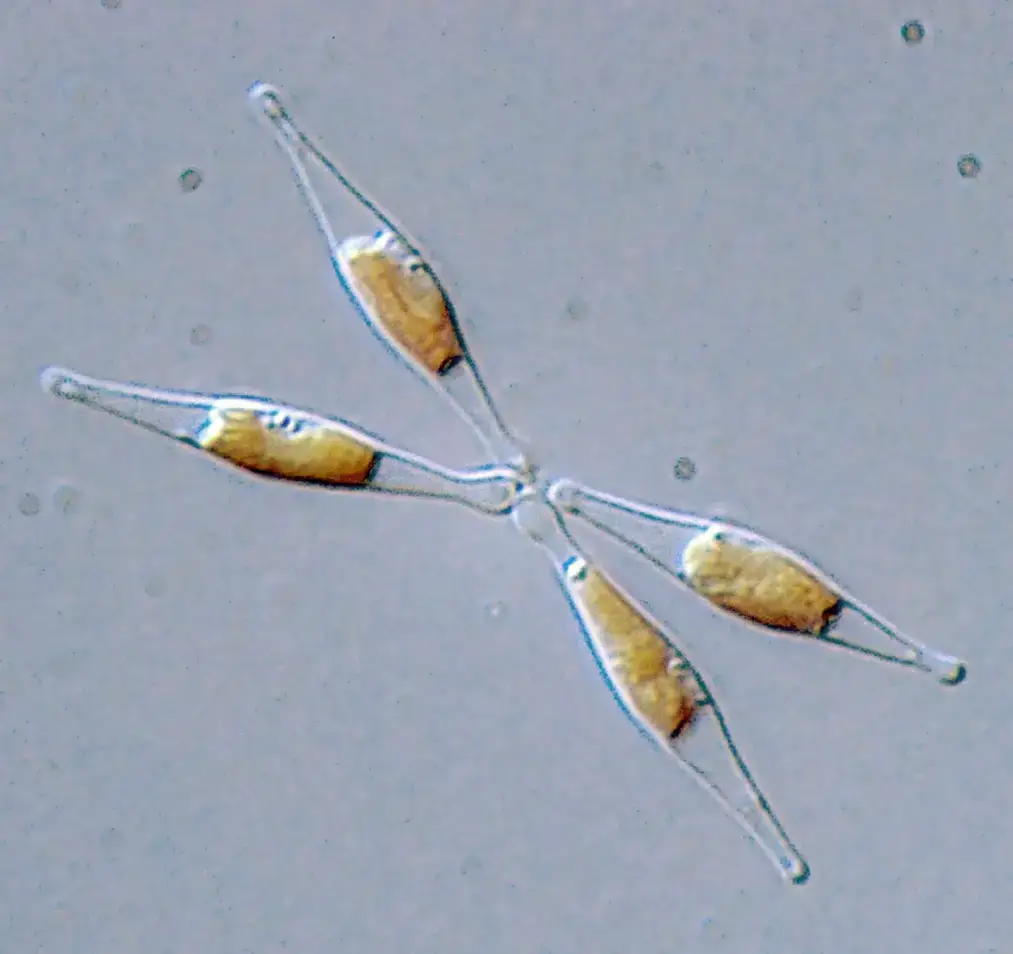
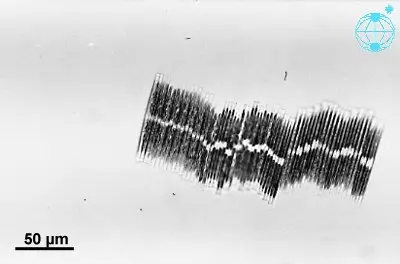
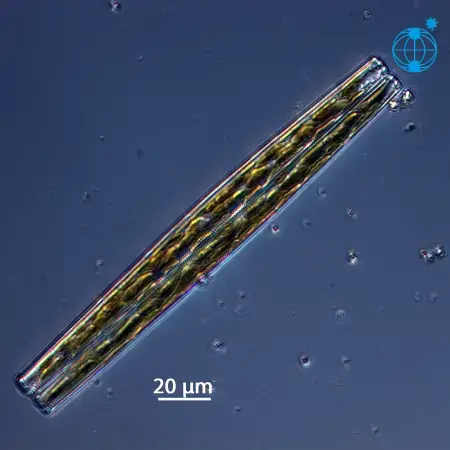
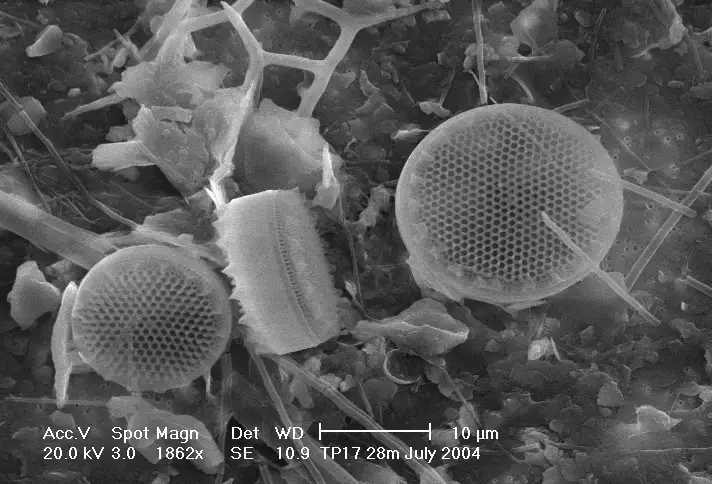
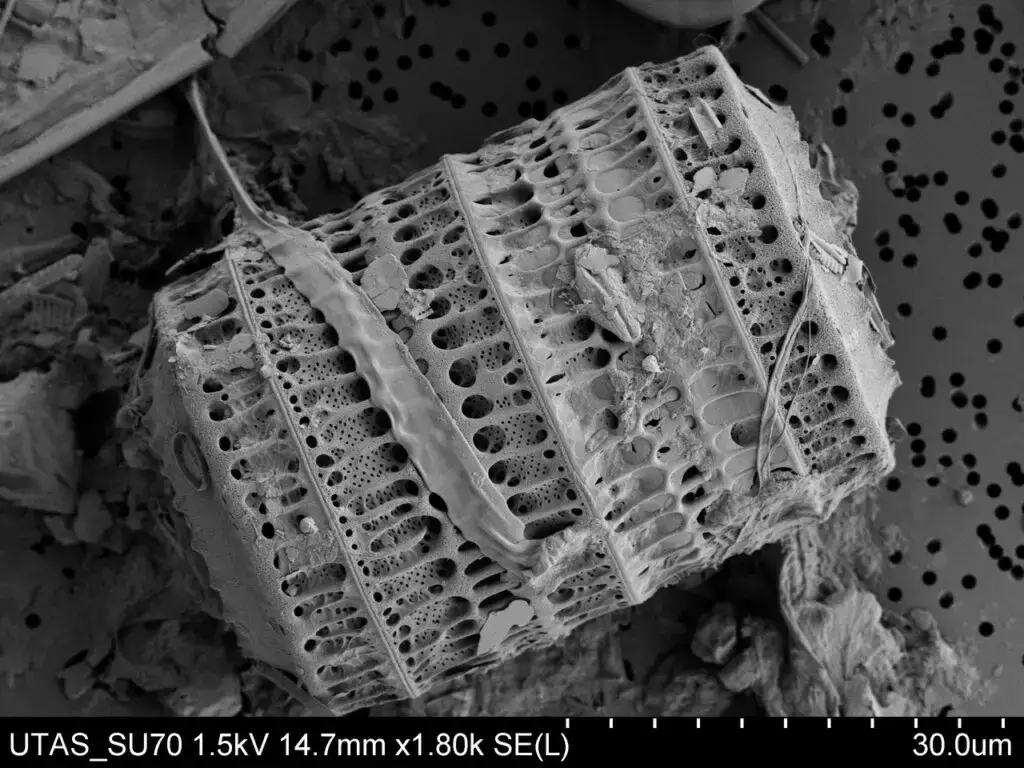
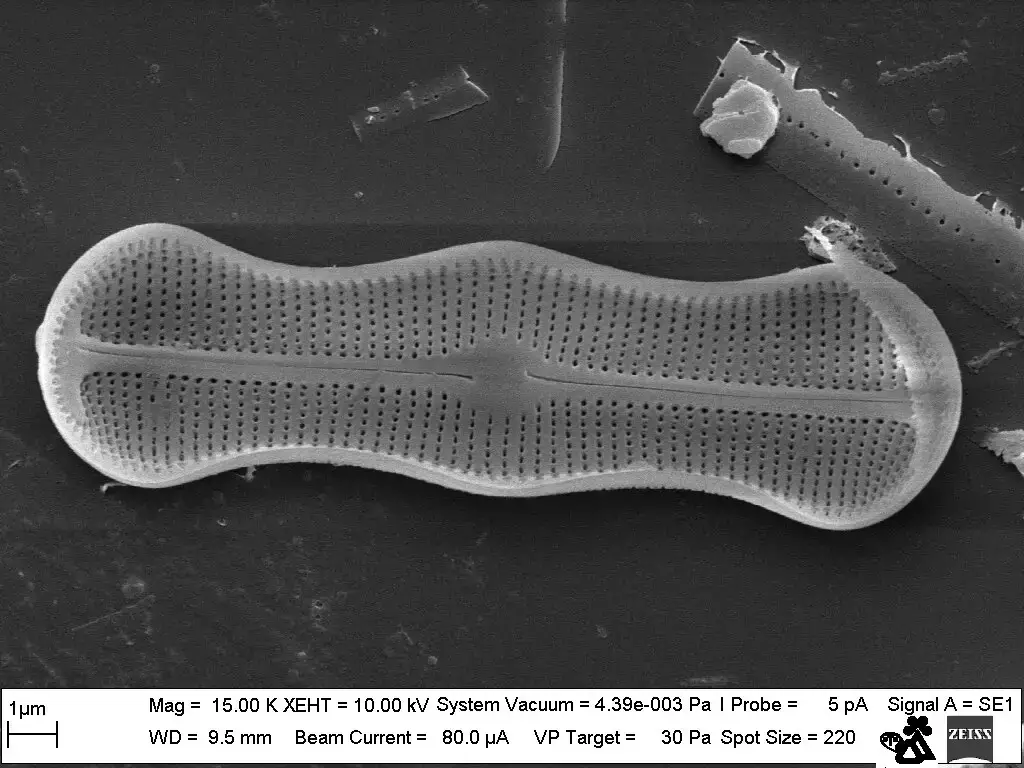
FAQ
What are diatoms?
Diatoms are single-celled microorganisms belonging to the group of algae called Bacillariophyta. They are known for their intricate and often beautifully patterned silica cell walls, called frustules.
Where are diatoms found?
Diatoms can be found in various aquatic environments, including oceans, freshwater bodies like lakes and rivers, and even damp terrestrial surfaces. They are a significant part of phytoplankton in many aquatic ecosystems.
How do diatoms contribute to the ecosystem?
Diatoms are important primary producers in aquatic ecosystems. Through photosynthesis, they convert carbon dioxide into organic matter, providing a vital food source for other organisms. They also play a role in the carbon and silica cycles.
What do diatoms look like?
Diatoms come in a wide range of shapes and sizes. They can be round, triangular, elliptical, or even more complex. Their cell walls, made of silica, have intricate patterns and structures that distinguish different species.
What is the significance of diatom frustules?
Diatom frustules have unique patterns that serve taxonomic and ecological purposes. Scientists can use these patterns to identify different species and gain insights into past environments through sediment analysis.
How do diatoms reproduce?
Diatoms reproduce asexually through a process called binary fission, where a single cell divides into two identical daughter cells. They can also reproduce sexually, producing gametes that fuse to form a zygote.
What is the ecological importance of diatoms?
Diatoms are crucial in marine and freshwater food chains, providing food for zooplankton and other organisms. They also play a role in the global carbon cycle by fixing carbon dioxide through photosynthesis.
How are diatoms used in industry?
Diatoms have industrial applications, such as being used in products like diatomaceous earth for filtration and polishing. Their intricate cell wall structures have potential uses in nanotechnology.
Can diatoms be harmful?
Some species of diatoms can produce harmful algal blooms, which can release toxins into the water and harm aquatic organisms. These blooms can disrupt ecosystems and impact water quality.
How are diatoms studied and researched?
Scientists use various methods, including microscopy, DNA analysis, and sediment core studies, to study diatoms. Their fossilized remains in sediment cores provide valuable information about past environmental conditions and climate change.
References
- Sabater, S. (2009). Diatoms. Encyclopedia of Inland Waters, 149–156. doi:10.1016/b978-012370626-3.00135-6
- https://microscopeclarity.com/diatoms-a-complete-overview/
- https://diatoms.org/what-are-diatoms
- https://www.ucl.ac.uk/GeolSci/micropal/diatom.html
- Text Highlighting: Select any text in the post content to highlight it
- Text Annotation: Select text and add comments with annotations
- Comment Management: Edit or delete your own comments
- Highlight Management: Remove your own highlights
How to use: Simply select any text in the post content above, and you'll see annotation options. Login here or create an account to get started.